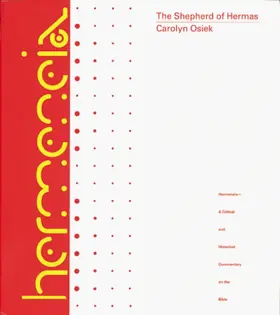

Shepherd of Hermas
in Hermeneia
Pages
292 pages
Publisher
Fortress Press
Published
1999
ISBN-13
9780800660635
Extremely popular in its time, The Shepherd of Hermas is a second-century work often used for instruction of catechumens, and in fact, is widely regarded as scripture. In it Hermas, a rich freed slave whose wealth was not always lawfully obtained, undergoes and relates several visions (including one from an angel disguised as a shepherd), repents, and offers advice on Christian teaching and behavior.
Comprehensive and careful, Carolyn Osiek's is the only full-length commentary on "The Shepherd" in English. Hermas's revelations afford us glimpses of religious imagination, social world, and moral ideals among early second-century Roma
Collections
This book appears in the following featured collections.
- Commentaries by Female Scholars by John Dyer
Reviews
Minneapolis: Fortress, 1999. Pp. xxi + 292, Cloth, $48.00, ISBN 0800660633. Graydon F. Snyder Chicago Theological Seminary Chicago, IL 60615 Osiek's translation and commentary on the Shepherd of Hermas for the Hermeneia series is the first in English since Snyder's (The Shepherd of Hermas (Camden: Nelson, 1969]). Osiek prefers the critical text of Molly Whittaker (p. 3) and, while following the traditional divisions (Visions, Mandates, Similitudes) in her translation, she also includes in brackets Whittaker's consecutive numbering system. In this introduction and commentary, Osiek, Professor of New Testament at Catholic Theological Union in Chicago, thoroughly updates pertinent bibliography, summarizes important research and offers her own critique of selected significant proposals. In short, this is a fine reliable commentary. Of course, any commentary reflects the interests of the commentator, and Osiek's particular professional interests do bring to this commentary some unique observations. Osiek has long been interested in the oral nature of early Christian literature (see bibliography, p. 268). She believes the uneven structure and language of Shepherd reflects the affect of oral presentations over a long period of time (pp. 13-16). She sees at least three characteristics: 1) She attributes incongruencies of the text to the additive and repetitive habits of the church rhetor. 2) In her translation Osiek shows, by means of [pl,], when the rhetor turns to address the listening congregation. This occurs often, but particularly at the end of a mandate (e.g., Mand. 4:10). 3) Osiek uses a more folksy translation in order to demonstrate the oral nature of a popular work. Osiek's work on the family in early Christianity (with David Balch, Families in the New Testament: Households and House Churches [Louisville: WJK, 1997]), reflects a longtime interest in gender and gender relationships. In the translation of Hermas she indicates gender when there may be some question (e.g., the congregation is addressed as "brothers and sisters" for adelphoi [Vis. 4.1.5]).
[Full Review]
